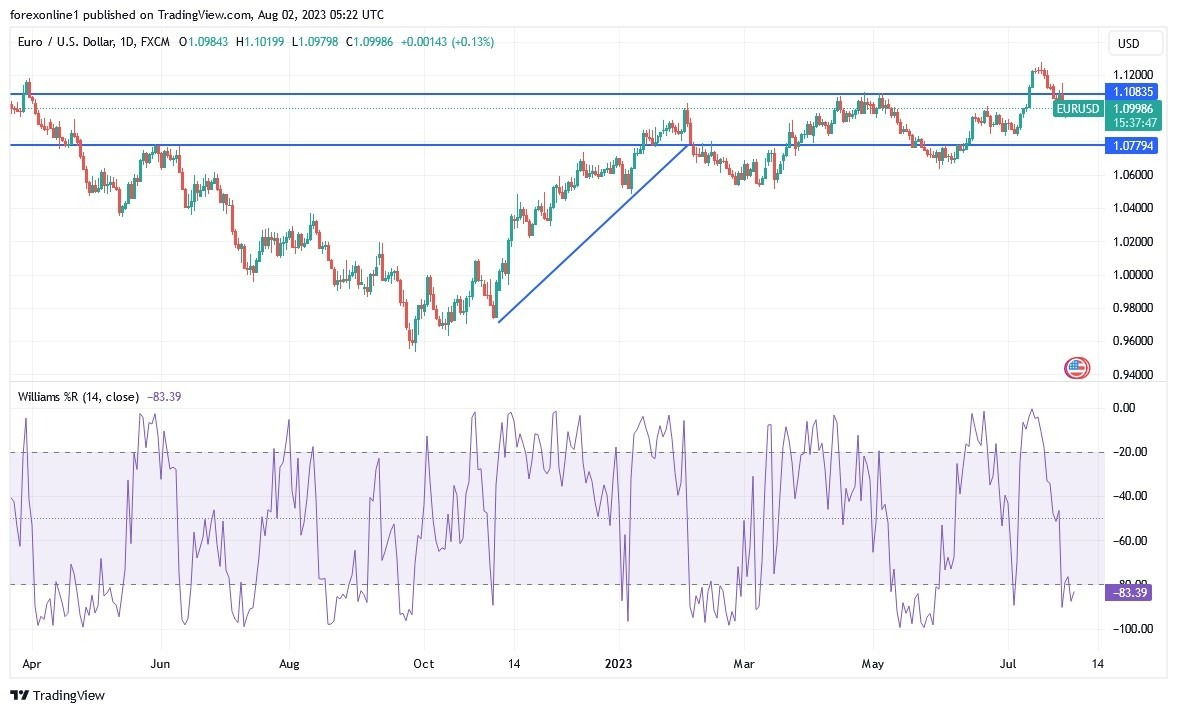Since the start of this week's trading, the price of the EUR/USD currency pair continued its losses, which extended to the support level of 1.0952, before settling around 1.1000 at the time of writing. As I expected, the currency pair will remain on its downward path until the reaction to the announcement of the US job numbers, which will have a direct reaction on the future expectations of raising the US interest rate.
Top Forex Brokers
On the other hand, the European economy has witnessed modest growth after months of stagnation, but high-interest rates designed to fight inflation cast a shadow as they make borrowing, investment, and spending more expensive for households and companies. The European Union's statistics agency Eurostat reported this week that the 20 countries that use the euro, and their 346 million inhabitants, saw growth of 0.3% in the April-June period, compared to the first three months of the year.
That's an improvement from zero growth in the first quarter and a slight dip in the fourth quarter of last year — but not by much. In addition, the one-off factors and massive outcroppings of Ireland made things look better than they really were. The Eurozone got a boost of 0.5% in France and 0.4% in Spain as lower inflation helped lift consumers' purchasing power.
However, the French figure increased and this statistical anomaly flattered French growth, but did little to mask weak demand for commodities in the Eurozone's second-largest economy. Ireland's growth of 3.3%, the largest in the eurozone, also soured the overall picture. Its growth figures often show significant fluctuations due to major international companies setting up their headquarters there, including tech giants like Meta, Google, and Apple.
Commenting on this, Franzisca Palmas, chief European economist at Capital Economics, said that without Ireland, growth in the eurozone would have been only 0.1%. Marc de Muizon, chief European analyst at Deutsche Bank Research, said that the overall figure "was driven by a few country idiosyncrasies and masks an underlying momentum that is likely much closer to recession."
Europe's largest economy, Germany, struggled in the second quarter, posting zero growth after two consecutive quarters of lower output as it grappled with rising energy costs linked to Russia's war in Ukraine. Italy, the third economy, contracted 0.3%. Eurozone growth figures for the first quarter were revised down from 0.1%, statistically erasing what had been two consecutive quarters of contraction - one definition of a recession.
Meanwhile, inflation in the eurozone continued its gradual decline, falling to 5.3% in July from 5.5% in June. Europe is still reeling from the repercussions of the Russian invasion of Ukraine, including Moscow cutting off most of its natural gas from the continent, which led to a sharp rise in fuel prices and the electricity it generates. And in Germany, the Vice-Chancellor and Economics Minister for Europe, Robert Habeck, has proposed a cap on energy prices for an industry with the help of the government.
Otherwise, the forecast for the rest of the year is muted. Another drag on the economy is the rapid series of interest rate increases launched by the European Central Bank to stem inflation. The European Central Bank raised its ninth rate in a row last Thursday, bringing the main interest rate on deposits from 0.5% to 3.75% in just one year, a record pace since the creation of the euro in 1999. The result was higher mortgage rates and the cancellation of mortgage plans. Construction due to credit is expensive or unavailable.
EUR/USD Technical Outlook
- The price of the EUR/USD currency pair has formed higher lows on the daily time frame, connected to a steady upward trend line since March this year. It appears that another test of support is in the works.
- The Fibonacci retracement tool shows that this is in line with the 61.8% level and the former resistance area around the key psychological level of 1.0900.
- This also coincides with the dynamic support of the 100 SMA which adds to its strength as a floor.
And if this is enough to keep the losses in check, EUR/USD could resume the climb to the swing high at 1.1271 or higher. The 100 SMA is above the 200 SMA to confirm that the near-term trend has turned higher or that the support is likely to hold further than to be broken.
The stochastic is still moving lower and has room to go before signaling oversold levels. Once the oscillator turns higher, the bullish momentum may return and allow the uptrend to resume. The RSI has more room to cover before it reverses exhaustion among the sellers, so the correction could continue until the oscillator reaches oversold territory and returns higher. A breakout below the area of interest may indicate a long-term reversal.
 Ready to trade our Forex daily forecast? We’ve shortlisted the best FX trading platform in the industry for you.
Ready to trade our Forex daily forecast? We’ve shortlisted the best FX trading platform in the industry for you.

